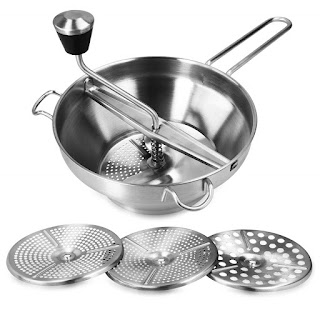|
Ingredients
for PASSATA
|
|||
|
Yield: 4 cups
(1 Litre/Quart)
|
Yield: 18 cups
(4.5 Litres/9 Pints)
|
Yield: 28 cups
(7 Litres /7 Quarts)
|
|
|
Tomatoes,
Roma, Fresh or Thawed, Fully Ripe
|
2.25kg (5 pounds)
|
9.5kg (21 pounds)
|
15.5kg (35 pounds)
|
|
Citric
Acid*
|
1/2 teaspoon
|
2 1/4 teaspoons
|
3 1/2 teaspoons
|
|
Salt,
Finely Ground (Optional)
|
1 teaspoon
|
4 1/2 teaspoons
|
7 teaspoons
|
|
*Citric acid can be replaced with bottled lemon
juice: add 1 tablespoon bottled lemon juice per pint/500ml jar (2 tablespoons
bottled lemon juice per quart/litre jar);
Citric acid is recommended if available.
|
|||
 2. Use a knife to remove tomato seeds and place
tomato halves into a large pot. Repeat until the pot is full (or you have
finished de-seeding all the tomatoes). Depending on your batch size, you may
need several stock pots. Removing the seeds before heat is applied results in a
naturally sweet tomato flavour – the seeds add bitterness to your passata if
used.
2. Use a knife to remove tomato seeds and place
tomato halves into a large pot. Repeat until the pot is full (or you have
finished de-seeding all the tomatoes). Depending on your batch size, you may
need several stock pots. Removing the seeds before heat is applied results in a
naturally sweet tomato flavour – the seeds add bitterness to your passata if
used.

5. Place jar lids into a bowl and cover lids with boiling water. Remove the lids from the water when you are ready to place them onto the jars to seal.
|
Processing Time for Passata
in a Boiling Water Canner
|
|||||
|
Altitude Processing Times
|
|||||
|
Packing
Style
|
Jar Size
|
0-1000ft
|
1001-3000ft
|
3001-6000ft
|
6000+
|
|
Hot Pack
|
< Pints
(500ml)
|
35
minutes
|
40
minutes
|
45
minutes
|
50
minutes
|
|
<
Quarts (1L)
|
40
minutes
|
45
minutes
|
50
minutes
|
55
minutes
|
|
|
Processing
Time for Passata in a Weighted Gauge Pressure Canner
|
||||
|
Altitude
Pressure Levels
|
||||
|
Packing Style
|
Jar Size
|
Processing Time
|
0-1000ft
|
>1000ft
|
|
Hot Pack
|
< Quarts (1L)
|
20 minutes
|
5lb
|
10lb
|
|
15 minutes
|
10lb
|
15lb
|
||
|
10 minutes
|
15lb
|
Not Recommended
|
||
|
Processing
Time for Passata in
a Dial Gauge Pressure Canner
|
||||||
|
Altitude
Pressure Levels
|
||||||
|
Packing Style
|
Jar Size
|
Processing Time
|
0-2000ft
|
2001-4000ft
|
4001-6000ft
|
6001-8000ft |
|
Hot Pack
|
< Quarts (1L)
|
20 minutes
|
6lb
|
7lb
|
8lb
|
9lb |
|
15 minutes
|
11lb
|
12lb
|
13lb
|
14lb |
||
o Ensure tomatoes are red and fully ripe – if needed, ripen tomatoes in the sun for a few days before making passata;
o Use paste tomato varieties, like roma or san marzano – field/round varieties are higher in water (resulting in a lower yield of passata per batch);
o For small batches of passata, use a food mill (or attachment for your bowl mixer with a coarse plate attached);
o For larger batches, a manual or an electric tomato strainer is very helpful! We use a 0.4hp tomato machine but some electric mincing machines also have tomato attachments which is what we recommend to our students. Manual tomato strainers are lower in cost (often available second-hand);
o You will need a large pot (or several) to cook the tomatoes – we use several 10 litre stock pots ideal, as they can be stacked when not in use (compared to large passata pots that are more expensive to purchase and store);
o After cooking the tomatoes, use a fine mesh strainer to remove tomato water (if the passata is too runny) to make the fresh passata thicker and denser.


